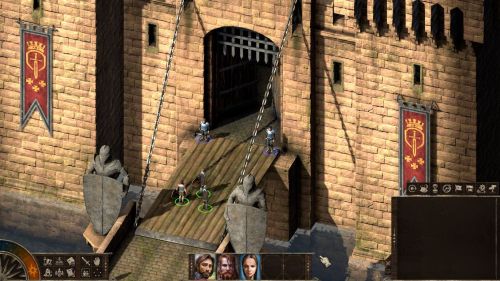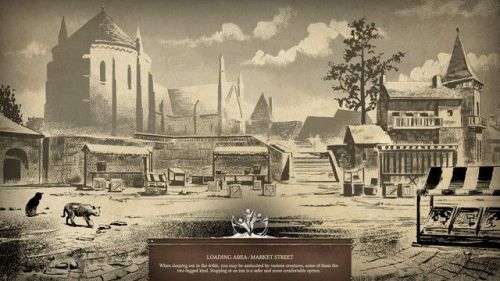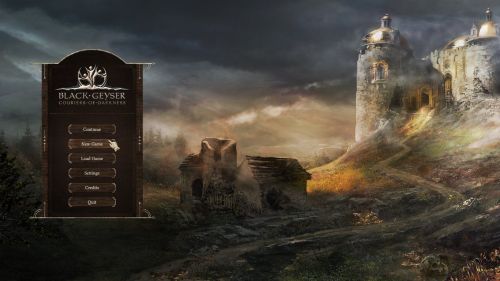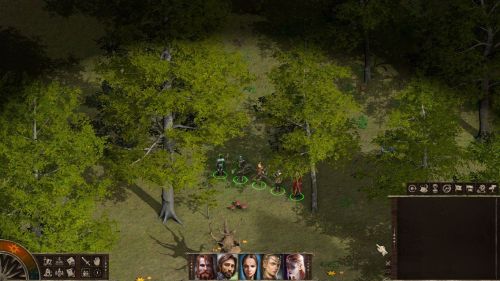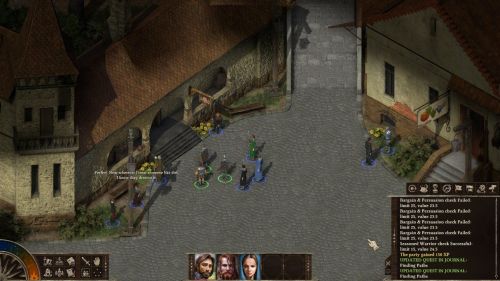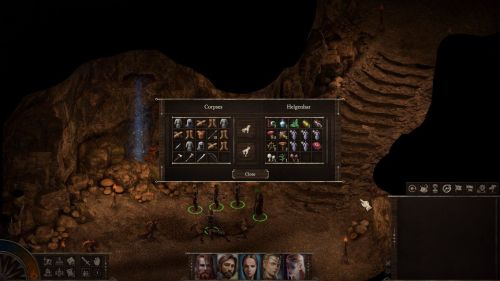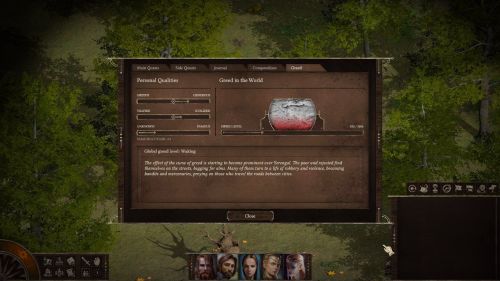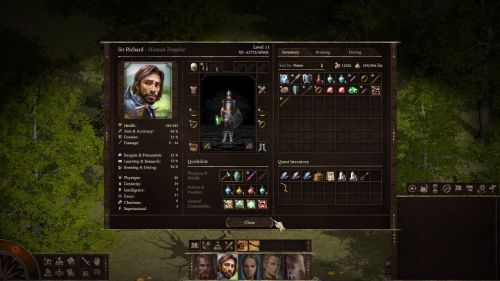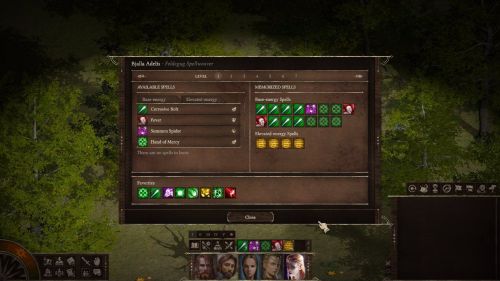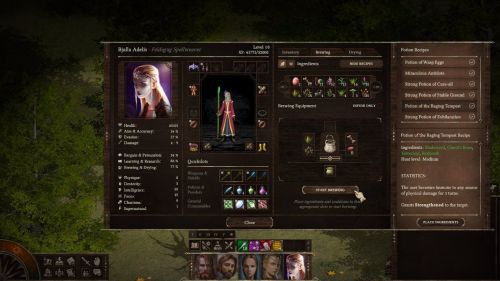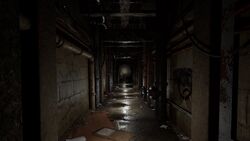RPG Codex Review: Black Geyser
RPG Codex Review: Black Geyser
Codex Review - posted by Darth Roxor on Fri 28 July 2023, 18:29:16
Tags: Black Geyser: Couriers of Darkness; GrapeOcean Technologies[Review by Lady Error]
During its seven years of development, Black Geyser: Couriers of Darkness was widely considered vaporware or a joke title from a completely unknown indie developer from Hungary and Austria. But, lo and behold, it did get a release last year on March 17, as the Codex reported. After giving them time to polish up the game with some updates and bug fixes, let us now take a closer look at it.
Black Geyser was inspired by both the Baldur's Gate and the Pillars of Eternity series – which was also the main selling point during its Kickstarter campaign in April 2018. The UI is almost an exact (and some say, rather shameless) copy of the user interface in Pillars of Eternity, while almost everything else is very similar to Baldur's Gate. But more on that later.
Part I: Biggest issues
Loading times
The loading times in Black Geyser were a major problem when it came out, but this has been fixed this year. In the latest version of the game, loading an area takes about 10-20 seconds (depending on graphics quality) and you need to wait about 5 seconds to enter a house inside an area. That is if you have an SSD drive, as an HDD drive would take longer. Pillars of Eternity also had similar loading time issues, which were partially resolved in the second installment.
Difficulty level
Even on the highest difficulty (out of four), there aren't many challenging fights once you have your party of five together. I say this assuming that you are a veteran RPG player and that you know what you are doing. Still, the highest difficulty level should definitely be more challenging, and it is something that has been addressed to some degree by post-release updates to the game.
Combat magic issues
The real-time with pause combat works well enough. However, there is not enough information about the status effects on enemies, e.g. what spells they are affected by. The only information you get is how badly the enemies are injured (from "slightly injured" to "near death").
This is a problem because without knowing what spells enemies have cast on themselves, you cannot really have "rock paper scissors"-type mage fights with hard counters. Such combat encounters are still unsurpassed in the Infinity Engine games such as Baldur's Gate. In Black Geyser you would have to follow the battle log really, really closely and take notes of what the enemy is casting. And even then you do not really know how long those spells last, etc.
The name of the game
We all heard the jokes about it. It is hard to understand why a team of people who put so much work into this could not come up with a better name than "Black Geyser". Does it impact the fun when playing it? Not really, but the overall impression is affected, e.g. when recommending this game to others.
Minor UI issues
There are only two user interface issues and both are somewhat or mildly annoying. The first one is that you always have to scroll the world screen manually – there is no option to let the screen scroll automatically as your characters get near the edge. The second is that clicking on your character portraits will often swap their places and there is no option to freeze the order in which they are displayed.
Only 5 characters
This questionable choice was already done in Pillars of Eternity II, while most traditional RPGs had 1, 4, 6 or 8 characters (including Baldur's Gate and the original Pillars of Eternity). It is hard to say whether or not having one more party member would have made much of a difference. It may have been nice to be able to use and explore one more class in the same playthrough, but combat is already almost too easy, even without adding another character. And keep in mind that this game offers a lot of options for summoning, so that you can always get "more help" as required. In fact, in the endgame you can summon dozens of creatures – and some of the major opponents in the final chapter can do this as well.
Slow beginning
The beginning of the game is its weakest part, in my opinion. You start as a servant who is saved from an attack by a mysterious stranger. That's all you know at that point. The real "hook" regarding what is going on and why you should care comes only after a few hours of gameplay. The first hour is more or less a tutorial that explains how the game works – which is necessary, even if not overly exciting. After that you are almost immediately dropped into one of the two large cities in the game. Large in this case means that the city has four different areas, which overall seemed smaller and less imaginitive than its Baldur's Gate counterpart. The real fun for me began once I left the city and started to explore the surrounding areas "Baldur's Gate-style."
Part II: What this game does well
Atmosphere and Exploration
The exploration reminds me a lot of the first Baldur's Gate, in that you can just go out and explore some wilderness areas or small towns in whatever order you wish. Black Geyser nails the atmosphere and charm of Baldur's Gate and feels pretty much like a classic Infinity Engine title. That is its biggest strength, even though the game world itself is rather generic. But then again, wasn't the world in the first Baldur's Gate rather generic too? That doesn't mean that it cannot be enjoyable. And there are in fact some good ideas in Black Geyser that surprised me pleasantly, especially a few of the quests.
Compared to Baldur's Gate 3, there are actually day and night cycles in Black Geyser, as well as different weather: rain, sun, shadows of clouds going over the landscape, etc. Some NPCs are only out at night, while the working ones are usually only in their shops during the day.
Graphics and Sound
The graphics have definitely somewhat lower production values and are not quite as pretty as in Pillars of Eternity, but they are still very well done. All the graphics – from the portraits, to the cities, forests and underground areas – are atmospheric and fitting to the medieval setting. And just as importantly, they evoke that Baldur's Gate charm or feeling that Pillars of Eternity struggled to recreate.
Similar praise goes to the sound effects in Black Geyser, which add well to the atmosphere. The main quest conversations also have voice overs that sound professional and well done. However, the music is mostly forgettable, though not too obtrusive. A few of the music tracks have a strange Far Eastern sound to them, while most of the others are in regular fantasy style.
Quests and Writing
The writing is concise and to the point, which already makes it much better than in Pillars of Eternity. There are also no gods that you have to deal with all the time, except indirectly on rare occasions. And while many quests are nothing special, quite a few do stand out with creativity.
For example, there is a time travel-themed quest in an underground area where the party needs to retrieve an antidote from a hostile group of cultists in the past and find a way to bring it to the present to save some allies. The difficulty is that all small magical items get destroyed by the time travel device, including the antidote.
The main quest focuses heavily on royal diplomacy in different kingdoms, which is a relatively new theme compared to the Infinity Engine titles. The majority of the quests can also be resolved in more than one way – often there is a pacifist solution available. There are even a few quests with heavy choices and consequences. Without spoiling too much, one of them really surprised me: when helping someone in need resulted in wiping out an entire peaceful settlement. And all the unresolved quests from that settlement were lost, though I did get a very powerful item as a "thank you."
Overall, this game is not too short, with a similar amount of content as the original Baldur's Gate. Black Geyser does not overstay its welcome.
Part III: What this game does merely okay
Greed System
The supposedly biggest innovation of this RPG is the introduction of a Greed system. Based on what choices you make in interactions with others, your greed can either grow or fall. For example, not taking money for completing a quest or donating a good amount at one of the churches decreases your party's greed bar. On the other hand, you can take as much loot from fallen enemies as you want, without ever influencing it.
However, there is hardly any effect from this Greed system on the gameplay itself, except that it may slow down or speed up greed taking over the world – there is a bar for that as well. This means that the introduction of this new mechanic is more or less cosmetic or flavor. It contributes to the atmosphere, but not much else.
Characters and Classes
The class or build system is rather traditional and offers a good selection of 5 races and 13 professions. What makes it stand out somewhat is that it is a different system that is not based on Dungeons & Dragons. So there is a certain freshness to it. And yes, unfortunately, the much anticipated Crushmaster was renamed to Highlander.
You start the game with just one character whom you create. Already in the first couple hours you meet four NPCs who can join your party. Alternatively and importantly, you can create up to four of the main character's "childhood friends" – and these can then also be found and recruited in the early areas.
Personally, I picked three NPCs and a Ranger whom I created myself, in addition to my Templar main character. The 2 tanks, 2 ranged attack characters and 1 spellweaver worked very well for me.
Magic and Skills
There are several magic schools for different classes. The selection of spells seems to be better than in Pillars of Eternity, but not quite as good as in Baldur's Gate or other Infinity Engine games. The main problem with magic was already mentioned above: you cannot see what defensive spells are active on enemy spellcasters.
In addition to the seven different magic classes, some martial classes such as Templars or Rangers can also start using magic at certain levels – while other classes have no access to magic at all, e.g. Fighters or Thieves. There are a lot of options for summoning creatures, which is also one of the best strategies throughout the game. Unfortunately, this simply means that the AI is not clever enough to prioritize between killing several (mostly harmless) wolves or the party that is inflicting a lot of damage.
The skill system in Black Geyser is divided into several parts: 3 general skills, 4-5 class skills and up to a dozen weapon skills. Overall, it is quite solid and nothing stands out negatively. Some skills top out at 10 points, while others top out at 15. The character stats are basically the same as in the Infinity Engine games or in Pillars of Eternity: Physique, Dexterity, Intelligence, Focus, Charisma and Supernatural. The latter is more or less a dump stat that increases some resistances, but it can also be used to let mages wear heavier armor.
Itemization and Crafting
Itemization is another area where Black Geyser offers nothing special but does nothing particularly bad either. The range of differences between beginner items and more advanced items is not as large here as in some other RPGs. There are also a few unique items, in addition to some others that are merely rare. Every character can equip quite a lot actually, including two rings, two bracelets and earrings, in addition to the usual helmet, armor, boots, belt and gauntlets. You can also equip two sets of weapons and switch between them in combat.
There are two types of crafting in Black Geyser: one for potions and one for powders. To craft anything, you first need to find recipes and ingredients such as herbs, just like in most other RPGs that offer such mechanics. In Black Geyser, crafting is somewhat more complicated (involving more steps and ingredients) but works fine overall. One of the fun things you can do with explosive powders is using your Thief to plant them on unsuspecting enemies while in stealth mode.
No wokeness and (almost) no romances
Considering that many find it offensive how many of the new RPGs include woke themes or extensive romances, there is none of that in this game. The romance option is limited to two dialogues you can have with a companion. It can be easily overlooked and you may not even notice its presence. There is also a bald black NPC you can recruit who only cares about killing as much as possible – a straightforward thing that you'd probably be hard-pressed to find in a game that would care about being woke.
Conclusion
For those who were disappointed with Pillars of Eternity (or are now disappointed with Baldur's Gate 3) as far as delivering a traditional "Baldur's Gate"-like experience is concerned, this game comes closer to it than any other RPG in the last 10-15 years. It does not stand out as great in my view, but still delivers a fun and enjoyable experience – once you get past the first few hours.
During its seven years of development, Black Geyser: Couriers of Darkness was widely considered vaporware or a joke title from a completely unknown indie developer from Hungary and Austria. But, lo and behold, it did get a release last year on March 17, as the Codex reported. After giving them time to polish up the game with some updates and bug fixes, let us now take a closer look at it.
Black Geyser was inspired by both the Baldur's Gate and the Pillars of Eternity series – which was also the main selling point during its Kickstarter campaign in April 2018. The UI is almost an exact (and some say, rather shameless) copy of the user interface in Pillars of Eternity, while almost everything else is very similar to Baldur's Gate. But more on that later.
Part I: Biggest issues
Loading times
The loading times in Black Geyser were a major problem when it came out, but this has been fixed this year. In the latest version of the game, loading an area takes about 10-20 seconds (depending on graphics quality) and you need to wait about 5 seconds to enter a house inside an area. That is if you have an SSD drive, as an HDD drive would take longer. Pillars of Eternity also had similar loading time issues, which were partially resolved in the second installment.
Difficulty level
Even on the highest difficulty (out of four), there aren't many challenging fights once you have your party of five together. I say this assuming that you are a veteran RPG player and that you know what you are doing. Still, the highest difficulty level should definitely be more challenging, and it is something that has been addressed to some degree by post-release updates to the game.
Combat magic issues
The real-time with pause combat works well enough. However, there is not enough information about the status effects on enemies, e.g. what spells they are affected by. The only information you get is how badly the enemies are injured (from "slightly injured" to "near death").
This is a problem because without knowing what spells enemies have cast on themselves, you cannot really have "rock paper scissors"-type mage fights with hard counters. Such combat encounters are still unsurpassed in the Infinity Engine games such as Baldur's Gate. In Black Geyser you would have to follow the battle log really, really closely and take notes of what the enemy is casting. And even then you do not really know how long those spells last, etc.
The name of the game
We all heard the jokes about it. It is hard to understand why a team of people who put so much work into this could not come up with a better name than "Black Geyser". Does it impact the fun when playing it? Not really, but the overall impression is affected, e.g. when recommending this game to others.
Minor UI issues
There are only two user interface issues and both are somewhat or mildly annoying. The first one is that you always have to scroll the world screen manually – there is no option to let the screen scroll automatically as your characters get near the edge. The second is that clicking on your character portraits will often swap their places and there is no option to freeze the order in which they are displayed.
Only 5 characters
This questionable choice was already done in Pillars of Eternity II, while most traditional RPGs had 1, 4, 6 or 8 characters (including Baldur's Gate and the original Pillars of Eternity). It is hard to say whether or not having one more party member would have made much of a difference. It may have been nice to be able to use and explore one more class in the same playthrough, but combat is already almost too easy, even without adding another character. And keep in mind that this game offers a lot of options for summoning, so that you can always get "more help" as required. In fact, in the endgame you can summon dozens of creatures – and some of the major opponents in the final chapter can do this as well.
Slow beginning
The beginning of the game is its weakest part, in my opinion. You start as a servant who is saved from an attack by a mysterious stranger. That's all you know at that point. The real "hook" regarding what is going on and why you should care comes only after a few hours of gameplay. The first hour is more or less a tutorial that explains how the game works – which is necessary, even if not overly exciting. After that you are almost immediately dropped into one of the two large cities in the game. Large in this case means that the city has four different areas, which overall seemed smaller and less imaginitive than its Baldur's Gate counterpart. The real fun for me began once I left the city and started to explore the surrounding areas "Baldur's Gate-style."
Part II: What this game does well
Atmosphere and Exploration
The exploration reminds me a lot of the first Baldur's Gate, in that you can just go out and explore some wilderness areas or small towns in whatever order you wish. Black Geyser nails the atmosphere and charm of Baldur's Gate and feels pretty much like a classic Infinity Engine title. That is its biggest strength, even though the game world itself is rather generic. But then again, wasn't the world in the first Baldur's Gate rather generic too? That doesn't mean that it cannot be enjoyable. And there are in fact some good ideas in Black Geyser that surprised me pleasantly, especially a few of the quests.
Compared to Baldur's Gate 3, there are actually day and night cycles in Black Geyser, as well as different weather: rain, sun, shadows of clouds going over the landscape, etc. Some NPCs are only out at night, while the working ones are usually only in their shops during the day.
Graphics and Sound
The graphics have definitely somewhat lower production values and are not quite as pretty as in Pillars of Eternity, but they are still very well done. All the graphics – from the portraits, to the cities, forests and underground areas – are atmospheric and fitting to the medieval setting. And just as importantly, they evoke that Baldur's Gate charm or feeling that Pillars of Eternity struggled to recreate.
Similar praise goes to the sound effects in Black Geyser, which add well to the atmosphere. The main quest conversations also have voice overs that sound professional and well done. However, the music is mostly forgettable, though not too obtrusive. A few of the music tracks have a strange Far Eastern sound to them, while most of the others are in regular fantasy style.
Quests and Writing
The writing is concise and to the point, which already makes it much better than in Pillars of Eternity. There are also no gods that you have to deal with all the time, except indirectly on rare occasions. And while many quests are nothing special, quite a few do stand out with creativity.
For example, there is a time travel-themed quest in an underground area where the party needs to retrieve an antidote from a hostile group of cultists in the past and find a way to bring it to the present to save some allies. The difficulty is that all small magical items get destroyed by the time travel device, including the antidote.
The main quest focuses heavily on royal diplomacy in different kingdoms, which is a relatively new theme compared to the Infinity Engine titles. The majority of the quests can also be resolved in more than one way – often there is a pacifist solution available. There are even a few quests with heavy choices and consequences. Without spoiling too much, one of them really surprised me: when helping someone in need resulted in wiping out an entire peaceful settlement. And all the unresolved quests from that settlement were lost, though I did get a very powerful item as a "thank you."
Overall, this game is not too short, with a similar amount of content as the original Baldur's Gate. Black Geyser does not overstay its welcome.
Part III: What this game does merely okay
Greed System
The supposedly biggest innovation of this RPG is the introduction of a Greed system. Based on what choices you make in interactions with others, your greed can either grow or fall. For example, not taking money for completing a quest or donating a good amount at one of the churches decreases your party's greed bar. On the other hand, you can take as much loot from fallen enemies as you want, without ever influencing it.
However, there is hardly any effect from this Greed system on the gameplay itself, except that it may slow down or speed up greed taking over the world – there is a bar for that as well. This means that the introduction of this new mechanic is more or less cosmetic or flavor. It contributes to the atmosphere, but not much else.
Characters and Classes
The class or build system is rather traditional and offers a good selection of 5 races and 13 professions. What makes it stand out somewhat is that it is a different system that is not based on Dungeons & Dragons. So there is a certain freshness to it. And yes, unfortunately, the much anticipated Crushmaster was renamed to Highlander.
You start the game with just one character whom you create. Already in the first couple hours you meet four NPCs who can join your party. Alternatively and importantly, you can create up to four of the main character's "childhood friends" – and these can then also be found and recruited in the early areas.
Personally, I picked three NPCs and a Ranger whom I created myself, in addition to my Templar main character. The 2 tanks, 2 ranged attack characters and 1 spellweaver worked very well for me.
Magic and Skills
There are several magic schools for different classes. The selection of spells seems to be better than in Pillars of Eternity, but not quite as good as in Baldur's Gate or other Infinity Engine games. The main problem with magic was already mentioned above: you cannot see what defensive spells are active on enemy spellcasters.
In addition to the seven different magic classes, some martial classes such as Templars or Rangers can also start using magic at certain levels – while other classes have no access to magic at all, e.g. Fighters or Thieves. There are a lot of options for summoning creatures, which is also one of the best strategies throughout the game. Unfortunately, this simply means that the AI is not clever enough to prioritize between killing several (mostly harmless) wolves or the party that is inflicting a lot of damage.
The skill system in Black Geyser is divided into several parts: 3 general skills, 4-5 class skills and up to a dozen weapon skills. Overall, it is quite solid and nothing stands out negatively. Some skills top out at 10 points, while others top out at 15. The character stats are basically the same as in the Infinity Engine games or in Pillars of Eternity: Physique, Dexterity, Intelligence, Focus, Charisma and Supernatural. The latter is more or less a dump stat that increases some resistances, but it can also be used to let mages wear heavier armor.
Itemization and Crafting
Itemization is another area where Black Geyser offers nothing special but does nothing particularly bad either. The range of differences between beginner items and more advanced items is not as large here as in some other RPGs. There are also a few unique items, in addition to some others that are merely rare. Every character can equip quite a lot actually, including two rings, two bracelets and earrings, in addition to the usual helmet, armor, boots, belt and gauntlets. You can also equip two sets of weapons and switch between them in combat.
There are two types of crafting in Black Geyser: one for potions and one for powders. To craft anything, you first need to find recipes and ingredients such as herbs, just like in most other RPGs that offer such mechanics. In Black Geyser, crafting is somewhat more complicated (involving more steps and ingredients) but works fine overall. One of the fun things you can do with explosive powders is using your Thief to plant them on unsuspecting enemies while in stealth mode.
No wokeness and (almost) no romances
Considering that many find it offensive how many of the new RPGs include woke themes or extensive romances, there is none of that in this game. The romance option is limited to two dialogues you can have with a companion. It can be easily overlooked and you may not even notice its presence. There is also a bald black NPC you can recruit who only cares about killing as much as possible – a straightforward thing that you'd probably be hard-pressed to find in a game that would care about being woke.
Conclusion
For those who were disappointed with Pillars of Eternity (or are now disappointed with Baldur's Gate 3) as far as delivering a traditional "Baldur's Gate"-like experience is concerned, this game comes closer to it than any other RPG in the last 10-15 years. It does not stand out as great in my view, but still delivers a fun and enjoyable experience – once you get past the first few hours.





